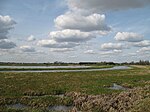Hockwold cum Wilton

Hockwold cum Wilton ("Hock/mallow wood and willow-tree farm/settlement") is 10 miles west of Thetford, Norfolk, England and is in the borough of King's Lynn and West Norfolk. It is located near several USAF airbases, notably RAF Lakenheath and RAF Mildenhall. It is situated on the boundary between the geographical areas of the Breckland – a region of sandy heathland now largely forested – and the flat, low-lying Fens, with some characteristics of both. The village is the location of the primary campus of Iceni Academy. Previously this was Hockwold Primary School. The village has two churches (St Peter's, now redundant and cared for by the Churches Conservation Trust, and St James') and a Methodist chapel.
Excerpt from the Wikipedia article Hockwold cum Wilton (License: CC BY-SA 3.0, Authors, Images).Hockwold cum Wilton
Main Street, King's Lynn and West Norfolk
Geographical coordinates (GPS) Address Nearby Places Show on map
Geographical coordinates (GPS)
| Latitude | Longitude |
|---|---|
| N 52.465 ° | E 0.542 ° |
Address
Main Street
Main Street
IP26 4LZ King's Lynn and West Norfolk
England, United Kingdom
Open on Google Maps









